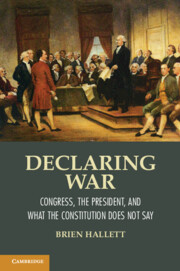Book contents
- Frontmatter
- Contents
- List of Figures
- Acknowledgments
- Prologue
- Miscellaneous Frontmatter
- 1 A Constitutional Tyranny and Presidential Dictatorship
- Part I What Is the History?
- Part II What Is a Declaration of War?
- Part III What Are the Solutions?
- 8 A Constitutional Amendment
- 9 A Congressional Work-Around
- Part IV What Is the Theory?
- Appendix I Five Congressional Declarations of War and One Appropriations Act
- Appendix II The Fœderative Powers in Parliamentary Governments
- References
- Index
9 - A Congressional Work-Around
Published online by Cambridge University Press: 05 November 2012
- Frontmatter
- Contents
- List of Figures
- Acknowledgments
- Prologue
- Miscellaneous Frontmatter
- 1 A Constitutional Tyranny and Presidential Dictatorship
- Part I What Is the History?
- Part II What Is a Declaration of War?
- Part III What Are the Solutions?
- 8 A Constitutional Amendment
- 9 A Congressional Work-Around
- Part IV What Is the Theory?
- Appendix I Five Congressional Declarations of War and One Appropriations Act
- Appendix II The Fœderative Powers in Parliamentary Governments
- References
- Index
Summary
The Congress shall have power … to declare war, grant letters of marque and reprisal, and make rules concerning captures on land and water.
(article I, section 8, clause 11)Each House may determine the rules of its proceedings.
(article I, section 5, clause 2)Short of an amendment to the Constitution, how might the Congress regain the initiative to decide on and draft its own declarations of war? For, he who controls the drafting largely controls the decision for war or peace. The answer, of course, is to enable the Congress to set its own agenda independently of the president. Not, of course, in all matters, most especially, not in terms of its peacetime lawmaking. For its peacetime lawmaking, presidential agenda setting and leadership are absolutely essential for two reasons: first, because of the need for close executive-legislative coordination and, second, for the purpose of overcoming the inherent problems of any large, majority-rule organization characterized by extremely high transaction costs, great difficulty in coordinating shared interests, and large collective action problems. Without strong leadership from the nation’s chief executive, the passing of appropriate and timely peacetime legislation would be impossible, as more than two hundred years of congressional history demonstrates. But war is not peace, and a declaration of war is not like an earmark for a “bridge to nowhere.” Different rules and procedures need to apply to the wartime and peacetime duties of the Congress.
More properly, the structural problem is to understand how and why the change from a committee-of-the-whole to a standing-committee organization created two insuperable barriers to the Congress’s initiating a procedurally perfect, fully reasoned declaration of war. The first barrier is related to quality – the inability of members to gain the required expertise. The second relates to quantity – the sheer number of members and the volume of their workload. The relationship between the two barriers is inverse: as quantity increases quality decreases. This makes it virtually impossible for the Congress to take the initiative to draft, debate, and vote its own fully reasoned declarations of war, as the Second Continental Congress did.
- Type
- Chapter
- Information
- Declaring WarCongress, the President, and What the Constitution Does Not Say, pp. 183 - 204Publisher: Cambridge University PressPrint publication year: 2012

